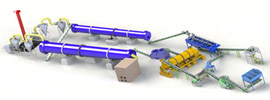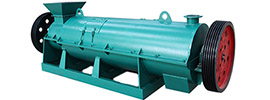The equipment configuration of a nutrient soil production line requires comprehensive design considering raw material types, production scale, automation requirements, and environmental protection standards. Below is a comprehensive list of equipment and configuration plans that cater to various production scales and process requirements:
I. Core Production Equipment
1. Raw Material Preprocessing System
- Crushing/Pulverizing Equipment
- Function: Processes coarse fibrous materials (coco coir, peat moss, bark) or mineral components (perlite, vermiculite).
- Selection Guide: Choose wet/dry models based on material moisture content (e.g., hammer mills). Match capacity to production scale.
- Screening Equipment
- Function: Separates impurities (sand, fiber clumps) and controls particle size distribution.
- Selection Guide: Rotary screens or vibratory screens with adjustable mesh sizes for different formulations.
- Conveying Systems
- Function: Connects production stages for automated material handling.
- Selection Guide: Belt conveyors or screw conveyors based on facility layout.
2. Batching & Mixing System
- Multi-Bin Dynamic Batching System
- Function: Precision blending of ≥3 components (e.g., coco coir, peat, perlite, fertilizers).
- Technical Features: Load cells + PLC control with ≤0.5% batching error, manual/auto switching.
- Selection Guide: Choose bin quantities (4/5-bin models) based on formulation complexity.
- Mixers
- Function: Homogeneous blending of diverse materials for consistent substrate quality.
- Selection Guide: Single-shaft batch mixers or twin-shaft continuous mixers matching production volume.
3. Forming & Packaging System
- Forming Equipment
- Function: Presses mixed substrate into blocks/pellets (e.g., coco bricks).
- Selection Guide: Coco brick presses (100-ton pressure, 0.6-5kg block weights) or pellet mills.
- Packaging Machines
- Function: Automatic weighing, filling, and sealing for various packaging formats.
- Selection Guide: Valve bag packers (bulk sales) or non-woven fabric packers (breathable for seedlings).
- Technical Specs: ±0.2% accuracy, 3-4 bags/minute throughput.
II. Automation & Control Systems
- PLC Full-Automation System
- Function: Integrates entire production flow with real-time monitoring of temperature, humidity, and ratios.
- Advantages: 20-30% efficiency gain through reduced manual intervention.
Selection Guide: Touchscreen operation with data logging/traceability capabilities.
- Inline Monitoring
- Sensors: Temperature, humidity, pH sensors feeding data to central control.
- Actuators: Automated water valves, compost turners for stable fermentation conditions.
III. Environmental & Auxiliary Equipment
- Dust Collection Systems
- Function: Captures airborne particles during crushing/mixing to meet PM10≤80μg/m³ standards.
Selection Guide: Pulse-jet dust collectors with integrated hoods for workshop air quality control.
- Composting Equipment (Optional)
- Function: Accelerates organic matter decomposition while eliminating pathogens.
Selection Guide: Windrow or in-vessel turners with temperature control (55-65°C fermentation range).
Example: Hengshun Machinery's compost turners.
IV. Production Capacity Solutions
| Daily Output (tons) |
Recommended Configuration |
| 10-20 |
Semi-automatic line (manual feeding + standalone controls) for small nurseries/R&D. |
| 30-50 |
Fully automated line (PLC control + packaging) with dust collection for commercial production. |
| 50+ |
Custom multi-line system with intelligent warehousing for ≥5,000 tons/year capacity. |
V. Specialized Process Support
- Sterilization: Steam or chemical treatment of raw materials to eliminate soil-borne pathogens.
- pH Adjustment: Precision dosing of lime/sulfur to achieve target pH 5.5-6.5.
- Additive Integration: Controlled blending of fertilizers/microbes for enhanced substrate fertility.
VI. Facility Layout Optimization
- Flow Design: Sequential arrangement of "Raw Materials → Crushing → Screening → Batching → Mixing → Forming → Packaging" to minimize material handling.
- Space Utilization: Vertical stacking in composting areas reduces footprint by 30%.
- Safety Measures: Emergency stops at critical stations and interlocked equipment for operator protection.
This translation maintains technical precision while adapting to native English industry terminology. Let me know if you need further customization based on specific formulation requirements, regional regulations, or targeted output volumes.
 Send us a Email
Send us a Email Wulong Industrial Cluster
Wulong Industrial Cluster Have any question?
Have any question?



















